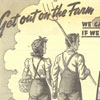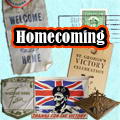Home | Living With War | Communities Go To War | The Women's War | Factories and Farms
Factories and Farms
At the outset of the Second World War, women who worked outside the home were in the minority. Those who did work faced limited opportunities and were restricted to fields considered women's work: nursing, teaching, social work, home economics, and library sciences. By the end of the war, women made up 17 percent of the labour force in Canada and were working in war industries and civilian jobs in all sectors of the economy.
With so many men enlisting, Canada faced a labour shortage as early as 1941, most notably in war-related industries. In 1942, the Canadian government passed the National Selective Service Act to mobilize the country’s labour resources for the benefit of the war effort. One of the main strategies of the program was to recruit women for the work force.
 Initially, only single women between the ages of 20 and 24 were required to register with the program. By 1943, the labour shortage had grown severe and older and married women were recruited, primarily for part-time positions. The federal government offered income tax incentives to those working in war-related industries to make the offer of a job more enticing. A Dominion-Provincial Wartime Day Nursery program was created to care for the children of working mothers. Alberta opted out because the two levels of government could not agree on a cost-sharing formula.
Initially, only single women between the ages of 20 and 24 were required to register with the program. By 1943, the labour shortage had grown severe and older and married women were recruited, primarily for part-time positions. The federal government offered income tax incentives to those working in war-related industries to make the offer of a job more enticing. A Dominion-Provincial Wartime Day Nursery program was created to care for the children of working mothers. Alberta opted out because the two levels of government could not agree on a cost-sharing formula.
Fewer war industries were located in Alberta than in central and eastern Canada, but the province boasted a larger pool, on a per capita basis, of employable young, single women. As a result, some women were required to move to other parts of the country.
The largest war-related business in the province was Aircraft Repair Ltd. located at Blatchford Field (air harbour/airport) in Edmonton. Aircraft Repair Ltd. was the busiest facility of its kind in the Commonwealth. The operation employed 3,000 workers, many of them women.
 Another important business linked directly to the war was Edmonton’s Great Western Garment Company (GWG). This garment manufacturing company was the largest facility of its kind in the Commonwealth and employed about 500 workers, roughly 90 percent of them women. During the war, the Great Western Garment Company became the major manufacturer of military clothing in Canada.
Another important business linked directly to the war was Edmonton’s Great Western Garment Company (GWG). This garment manufacturing company was the largest facility of its kind in the Commonwealth and employed about 500 workers, roughly 90 percent of them women. During the war, the Great Western Garment Company became the major manufacturer of military clothing in Canada.
Women living on farms took on the task of running these operations in the absence of their husbands and other male kin. Their efforts were critical in the production of food necessary to feed a growing military and parts of Europe ravaged by war.
 Farm work was not necessarily new to women. What was new was the nature of the work they performed to maintain their family farms. Women had traditionally participated in the operation of the farm by taking care of the smaller animals, making butter, helping to feed the livestock, and so forth. With the men gone, women were now going to have to operate, maintain, and repair the equipment and machinery; do the fieldwork; and help with harvest—this on top of their traditional activities. Over the course of the war, approximately 250,000 women across the country stayed on the land and farmed.
Farm work was not necessarily new to women. What was new was the nature of the work they performed to maintain their family farms. Women had traditionally participated in the operation of the farm by taking care of the smaller animals, making butter, helping to feed the livestock, and so forth. With the men gone, women were now going to have to operate, maintain, and repair the equipment and machinery; do the fieldwork; and help with harvest—this on top of their traditional activities. Over the course of the war, approximately 250,000 women across the country stayed on the land and farmed.
 During the war, the position of women in Canadian society changed dramatically. After the war, there was tremendous pressure on women for a return to normalcy. The government ended all programs designed to aid working women, who were encouraged—sometimes forced—to return to their traditional domestic sphere. Most women not working in pink-collar jobs were laid off and their jobs given to returning veterans. Some left the workforce voluntarily, but others who needed the income were forced out of their jobs. Edmonton's Local Council of Women had fought for equal pay for equal work during the war and opposed the dismissal of women after the war. The number of paid women workers did not rebound to wartime levels until the mid-1960s.
During the war, the position of women in Canadian society changed dramatically. After the war, there was tremendous pressure on women for a return to normalcy. The government ended all programs designed to aid working women, who were encouraged—sometimes forced—to return to their traditional domestic sphere. Most women not working in pink-collar jobs were laid off and their jobs given to returning veterans. Some left the workforce voluntarily, but others who needed the income were forced out of their jobs. Edmonton's Local Council of Women had fought for equal pay for equal work during the war and opposed the dismissal of women after the war. The number of paid women workers did not rebound to wartime levels until the mid-1960s.
References
Bannister, Lisa (ed.). Equal to the Challenge: An Anthology of Women's Experiences during WW2. Ottawa: Canada Department of National Defence, 2001.
MacPherson, Ian & Thompson, John Herd. “An Orderly Reconstruction: Prairie Agriculture in World War Two.” Canadian Papers in Rural History, Vol. 4, ed. Donald H. Akenson. Gananoque, Ontario: Langdale Press, 1984.
Morin, Renée. “Women after the War.” Canadian Affairs. 2, 4 (1945).
Pierson, Ruth Roach. “They're Still Women After All.” The Second World War and Canadian Womanhood. Toronto: McClelland & Stewart, 1986.








